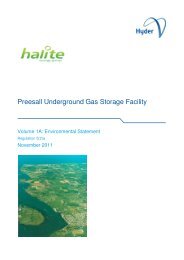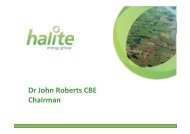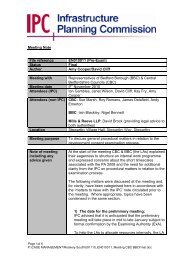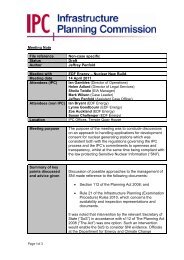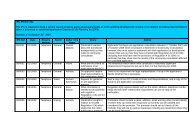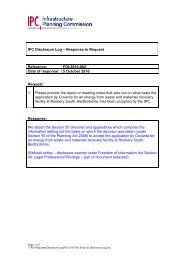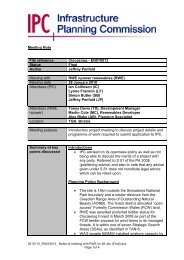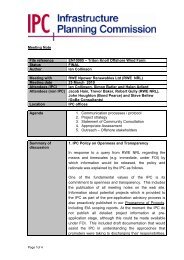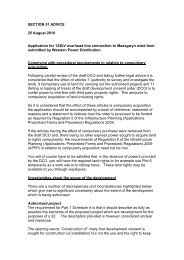IPC guidance note 1 - National Infrastructure Planning
IPC guidance note 1 - National Infrastructure Planning
IPC guidance note 1 - National Infrastructure Planning
You also want an ePaper? Increase the reach of your titles
YUMPU automatically turns print PDFs into web optimized ePapers that Google loves.
<strong>IPC</strong> GUIDANCE NOTE 1 ON PRE-APPLICATION STAGES (CHAPTER 2<br />
OF THE PLANNING ACT 2008)<br />
7 December 2009<br />
Introduction by the Chair of the <strong>IPC</strong><br />
The <strong>Planning</strong> Act 2008 (“Act”) has transformed the arrangements for obtaining<br />
development consent for nationally significant infrastructure projects. The new<br />
regime offers advantages for all concerned, including improved opportunities<br />
for the public, local authorities, consultees and objectors to get involved and<br />
have their say.<br />
This <strong>guidance</strong> is about the pre-application stage and a key aspect of the new<br />
system is the promoter’s responsibility in the period leading up to submitting<br />
an application to the <strong>IPC</strong>. Promoters need to encourage and listen to a large<br />
number of people and organisations when developing their proposals. This<br />
document will help promoters see how they should do this and comply with<br />
statutory requirements for their applications. It also underlines how important<br />
it is for promoters to do the job well, and the responsibility on others to take<br />
part in that process. The <strong>IPC</strong>’s role is to give advice and encourage parties to<br />
talk to one another at this stage and we hope this <strong>guidance</strong> will help<br />
promoters to engage effectively.<br />
Context<br />
1 This <strong>guidance</strong> is to assist those involved in the procedures leading up to<br />
the submission of an application for development consent for nationally<br />
significant infrastructure projects (NSIPs). The relevant statutory<br />
provisions and <strong>guidance</strong> prepared by the Secretary of State should<br />
be read first, and this is detailed below.<br />
1
2 An applicant for development consent must have regard to this <strong>guidance</strong><br />
under s50 of the Act. Other parties may find it useful to enhance<br />
understanding of the procedures before an application is submitted<br />
formally to the <strong>IPC</strong>.<br />
3 This is the first <strong>guidance</strong> <strong>note</strong> produced by the <strong>IPC</strong> on the pre-application<br />
stages and it will be developed further as all parties gain more experience<br />
of the process. We therefore welcome comments on the content of this<br />
<strong>guidance</strong> especially where examples of best practice have been<br />
developed.<br />
4 The legislation at the date of publication of this <strong>guidance</strong> and relevant to<br />
these pre-application activities includes:-<br />
• The <strong>Planning</strong> Act 2008 (“Act”) (s 37(3)(c)), and Part 5 Chapter 2);<br />
• The <strong>Infrastructure</strong> <strong>Planning</strong> (Applications: Prescribed Forms and<br />
Procedure) Regulations 2009 (regs 3-4 and 12) (“APFP”);<br />
• The <strong>Infrastructure</strong> <strong>Planning</strong> (Environmental Impact Assessment)<br />
Regulations 2009 (regs 4-11) (“EIA Regulations”);<br />
• The <strong>Infrastructure</strong> <strong>Planning</strong> (Model Provisions) (England and Wales)<br />
Order 2009 (“Model Provisions Order”);<br />
• The Conservation (Natural Habitats etc) Regulations 1994 and<br />
Conservation (Natural Habitats, etc.) (Amendment) (No.2) Regulations<br />
2009 (“Habitats Regulations”).<br />
5 The relevant <strong>guidance</strong> published by Communities and Local Government<br />
is ‘<strong>Planning</strong> Act 2008: Guidance on pre-application consultation’. This<br />
<strong>IPC</strong> <strong>guidance</strong> document supplements that <strong>guidance</strong> and avoids<br />
duplication.<br />
6 This <strong>guidance</strong> on pre-application consultation relates the consultation<br />
requirements to the procedural steps to be taken on the EIA screening<br />
and scoping process and to a determination of whether the project<br />
requires an appropriate assessment to be undertaken by the <strong>IPC</strong> under<br />
the Habitats Regulations.<br />
7 The <strong>guidance</strong> that follows addresses in particular procedural issues<br />
concerning the following steps, and how those interrelate:-<br />
• Options for pre-application programme;<br />
2
• Notification to the <strong>IPC</strong> of the application;<br />
• Consulting the local community.<br />
Options for pre-application programme<br />
8 The statutory requirements allow some flexibility for promoters to<br />
determine the most applicable programme by which they will be able to<br />
comply most effectively with their duties. The overriding intention of the<br />
legislation is to ensure that detailed matters are consulted upon and<br />
solutions or mitigation negotiated with the local community, landowners,<br />
statutory consultees and local authorities before submission of the<br />
application for development consent to the <strong>IPC</strong>.<br />
9 The <strong>IPC</strong> encourages applicants to submit draft application and supporting<br />
documents to it whilst it carries out its consultation and works up detailed<br />
proposals in order that quality issues can be identified before the<br />
application is submitted to the <strong>IPC</strong>. The <strong>IPC</strong> will not advise on merits of<br />
proposals but will be able to provide applicants with non-binding feedback<br />
as to whether the documents are likely to cover sufficient material and<br />
have been prepared to the necessary high standards. When submitting<br />
documentation to the <strong>IPC</strong> applicants should also submit it to the local<br />
authority and other parties with whom consultation is ongoing. This will<br />
ensure that those bodies are aware of the nature of the exercise that is<br />
being undertaken and so they may provide suggestions to the applicant<br />
should they wish to do so. Guidance has been produced on the<br />
production of application documents (see the CLG <strong>guidance</strong> <strong>note</strong> and the<br />
<strong>IPC</strong> <strong>guidance</strong> <strong>note</strong> 2).<br />
10 Annex B of CLG <strong>guidance</strong> shows in diagrammatic form two options for the<br />
pre-application process; one example shows discrete phases of<br />
consultation related to the scoping of an environmental statement to be<br />
submitted with any application. Other options are possible.<br />
11 Where an application will be subject to processes under the EIA<br />
Regulations and the Habitats Regulations there will be considerable<br />
consultation with statutory environmental bodies, and others with useful<br />
local knowledge, to obtain their considered views on the potential<br />
3
environmental impacts of a proposal. It is for promoters to best judge at<br />
what stage in the formulation of project proposals to commence formal<br />
consultation with those bodies and how that relates to the local<br />
community consultation.<br />
12 The following steps are set out in summary here - with more detail below -<br />
as the <strong>IPC</strong>’s view of the most likely order (some steps will be undertaken<br />
in parallel) for various procedural steps:<br />
• Notification or request for screening direction from <strong>IPC</strong> under regulation<br />
6 of the EIA Regulations.<br />
• Submission of material to the <strong>IPC</strong>, on whether the project is or is not<br />
considered likely to have a significant effect on a European site. The<br />
applicant will need to consult with statutory environmental bodies 1 (and<br />
other relevant authorities where additional consents e.g. in respect of<br />
SSSIs may be required) on this issue and the <strong>IPC</strong> would welcome<br />
representations and supporting information from promoters on this<br />
matter at a very early stage.<br />
• Request for scoping opinion from the <strong>IPC</strong> on the required<br />
environmental statement under regulation 8 of the EIA Regulations.<br />
This step may occur after a s46 notification.<br />
• s46 notification to <strong>IPC</strong> accompanied by such documents as required for<br />
s42 consultation to be undertaken with local authorities, statutory<br />
consultees, landowners and others significantly affected (see<br />
paragraphs 14-15 below). This step must occur on or before the s42<br />
consultation start date.<br />
• Formal consultation on the proposed application under s42 with local<br />
authorities, statutory consultees and landowners (see further below).<br />
• s47 duty to first consult the local authority in respect of the Statement<br />
of Community Consultation (“SOCC”). The SOCC needs to state<br />
whether the proposal is EIA development and how the preliminary<br />
environmental information is to be consulted upon (Reg 10 of the EIA<br />
Regulations), and so when an applicant consults a local authority on<br />
1 This term is commonly used by those involved in nature conservation and<br />
planning processes and here means those organisations that have a statutory role<br />
in commenting on nature conservation issues.<br />
4
the SOCC the local authority will need to have the preliminary<br />
environmental information so that its response can be an informed one.<br />
The consultation with local authorities under s42 and contact with local<br />
authorities on the SOCC under s47 can occur in parallel.<br />
• Publicising the application under s48 and regulation 4 of APFP It would<br />
be helpful if the published deadlines for receipt of views on the<br />
application are as close as possible to deadlines given to landowners<br />
and local authorities etc. in the s42 consultation.<br />
13 Applicants should be aware that where insufficient information (either for<br />
the purpose of EIA Regulations or Habitats Regulations assessments has<br />
been provided to the <strong>IPC</strong> at application stage the <strong>IPC</strong> will refuse to accept<br />
the application (see <strong>IPC</strong> <strong>guidance</strong> <strong>note</strong> 2) and therefore early consultation<br />
with the <strong>IPC</strong> on these issues is very important.<br />
Notifying the <strong>IPC</strong> of a proposed application<br />
14 If the promoter considers that the project is a NSIP which requires<br />
development consent under the Act, it must notify the <strong>IPC</strong> of the proposed<br />
application (s46). This must be done on or before commencing formal<br />
pre-application consultation and the <strong>IPC</strong> must be sent the same<br />
information as proposed to be used for the s42 consultation; the intention<br />
is therefore that the two steps will happen relatively close together.<br />
15 The <strong>IPC</strong> encourages applicants to notify it as soon as feasible as it assists<br />
the <strong>IPC</strong> in its processing both by allocating staff to particular projects and<br />
by storing and managing information received relating to a definite<br />
proposed project.<br />
Consultation stages<br />
16 Deciding when to submit a formal s46 notification to the <strong>IPC</strong> will depend<br />
to some extent on how the promoter wishes to carry out its formal<br />
consultation. There are two separate formal stages of consultation on the<br />
proposed application: one under s42 with statutory consultees, local<br />
authorities, landowners and significantly affected persons and a second<br />
with the local community in accordance with the SOCC. Therefore the s42<br />
consultation can be carried out first and some changes to the scheme<br />
already made as a result - for example to take account of fundamental<br />
environmental issues such as flooding - before the community<br />
5
consultation is carried out. A balance needs to be achieved between<br />
providing well developed details which may only be possible after<br />
extensive project development work and a less precise definition which<br />
can be amended in the light of consultation. The <strong>IPC</strong> will expect the<br />
balance between these issues to be carefully considered, and it may be<br />
that an approach to the local authority under s47 prior to publishing the<br />
SOCC could seek the local authority’s advice on whether an early<br />
community consultation would be advisable in the circumstances of the<br />
case.<br />
17 here is nothing laid down in the Act or relevant Regulations that requires<br />
preliminary environmental information to be provided at the s42<br />
consultation stage 2 but it is important to be aware of the matters to be<br />
publicised about the application (under s48 and Reg 4 of the APFP) and<br />
importantly the s49 duty to take account of responses to both the s42<br />
consultation and to the local community consultation. If very little<br />
information on the project is provided to local authorities, statutory<br />
consultees, landowners and others at the s42 stage, the ability to<br />
demonstrate comments have been taken into account in developing the<br />
proposal could be hampered. The promoter is of course encouraged to<br />
carry out on-going consultation with statutory consultees before<br />
submitting its application to the <strong>IPC</strong>; this will assist the promoter to comply<br />
with its s49 duty.<br />
18 It is therefore possible to comply with the statutory requirements under<br />
s46 and s42 of the Act with less than full information on the application,<br />
but unless there is a clear iterative consultation process followed and<br />
further documentation provided to consultees during the process the<br />
promoter will risk being unable to demonstrate that the scheme was<br />
carefully considered in the light of consultation responses received. The<br />
consultation report to be submitted with the application is where the<br />
promoter will set out how in its view it has complied with its duties (see<br />
<strong>IPC</strong> <strong>guidance</strong> <strong>note</strong> 2).<br />
2 Paragraph 92 of CLG Guidance on pre-application consultation will be amended<br />
to take account of this point.<br />
6
Consultation with the local community and the role of the SOCC<br />
19 The principles and objectives for community consultation are fully<br />
explained in the CLG <strong>guidance</strong> on consultation, see in particular paras 8-<br />
20. There is a statutory duty on the potential applicant to carry out the<br />
consultation as proposed in the SOCC (s47(7)) and therefore the content<br />
of that document is important so that the community understands on what<br />
and how it will be consulted.<br />
Why involve local authorities?<br />
20 Local authorities need to be consulted on the content of the SOCC<br />
(s47(2)). Their knowledge is key. For example, socio-economic, cultural,<br />
historical and other characteristics may influence decisions on the<br />
geographical extent of consultation and the methods that will be most<br />
effective in the particular local circumstances. Local authorities will also<br />
hold valuable information on umbrella community groups in the local area<br />
which could complement responses from the population generally.<br />
Publication of SOCC<br />
21 Once finalised, the SOCC must be published in a newspaper circulating in<br />
the vicinity of the land (s47(6)(a)). In practice, to suit local press<br />
publishing requirements, the SOCC may need to be a concise document<br />
(see paragraphs 24-27 below on the SOCC content). However, in linear<br />
schemes affecting many different communities, there is no option but to<br />
include in the published SOCC all locations and dates for proposed local<br />
exhibitions or workshops, for example.<br />
22 The important point is that the published SOCC needs to provide<br />
sufficient information on the project and its impact on the community to<br />
encourage constructive participation, which means the community must<br />
know exactly what will be done. It may be advisable in some cases for<br />
promoters to also make available to the public a separate document<br />
which sets out in more depth the factors that had led to the view taken on<br />
consultation catchment, timing and methods to be employed and refer to<br />
this in the published SOCC.<br />
Consultation catchment<br />
7
23 The appropriate area for consultation must include ‘people living in the<br />
vicinity of the land’ (s47(1)). The CLG <strong>guidance</strong> especially paragraphs<br />
49-54 provides full <strong>guidance</strong> on this.<br />
Additional <strong>guidance</strong> on the content of the SOCC<br />
24 To ensure the local community appreciates the context within which they<br />
are being consulted, the SOCC should include a succinct summary of the<br />
<strong>IPC</strong>’s role as examining authority, and draw attention to the status of<br />
NPSs. If a relevant NPS is in place, it is important to provide a realistic<br />
steer to the local community on the appropriate scope of any subsequent<br />
feed-back. It should also highlight the importance of the pre-application<br />
consultation in relation to the examination process after an application is<br />
accepted by the <strong>IPC</strong>.<br />
25 The SOCC should provide sufficient detail of the project, referring to both<br />
positive benefits to the local community that would result from the<br />
development and to the issues which could be considered negative<br />
elements of the NSIP so as to encourage participation in the process. The<br />
scale of the proposal should be described. The SOCC should also<br />
indicate what information will be provided during the consultation process<br />
on the scope for any associated land restoration, landscaping, other<br />
mitigation or compensatory measures for natural habitats’ impact.<br />
26 The applicant should consider whether the most appropriate consultation<br />
will involve multiple stages, and whether there is a role for building<br />
knowledge at early stages which could help communities understand<br />
either technical or other elements of the proposal. It is more likely that the<br />
quality of response and the sense of satisfaction felt in the community that<br />
views have been taken seriously will be enhanced by enabling members<br />
of the public to give valuable, informed local insights. If the promoter<br />
decides such methods are appropriate to the scheme, the details should<br />
be included in the SOCC.<br />
27 If relevant, the SOCC should also take account of any other major<br />
consultation exercises being undertaken in the area, for example in<br />
relation to planning applications or development plans proceeding under<br />
different legislation. The aim should be to achieve a programme that<br />
minimises confusion and possible ‘consultation fatigue’. If the NPS<br />
8
elevant to the proposal is not yet in place and consultation on a draft<br />
NPS is planned or underway the SOCC publication and subsequent<br />
consultation should ideally follow the NPS consultation.<br />
Transitional arrangements<br />
28 Promoters who have complied with regulation 12 of the APFP can take<br />
advantage of the transitional arrangements that apply to applications<br />
submitted to the <strong>IPC</strong> before 1 October 2011. This means that a promoter<br />
needs to have carried out between 1 October 2007 and 1 October 2009<br />
the following steps in connection with a proposed application for<br />
development consent:<br />
• commenced the s42 consultation i.e. with local authorities, all statutory<br />
undertakers detailed in schedule 1 of the APFP and landowners; and<br />
• commenced consultation with the local community;<br />
• publicised the proposed application in a way that “substantially fulfils”<br />
the requirements of regulation 4 of the APFP. The detail of the publicity<br />
undertaken need not be identical to regulation 4 but the promoter<br />
needs to be satisfied that the community will have been aware of the<br />
proposal so that the promoter is able to demonstrate how comments<br />
from the community and s42 consultation have been taken into account<br />
in the formulation of the proposals.<br />
29 Regulation 12 also requires the promoter to submit a report which says<br />
what the promoter has done and shows how responses received before<br />
deadlines set by the promoter as part of their consultation process have<br />
been taken into account.<br />
30 In summary the substance of the consultation process that applies to an<br />
application must have been complied with but the transitional<br />
arrangements allow that some of the detailed procedural steps taken can<br />
differ.<br />
Preparing for statements of common ground<br />
31 At the pre-application stage, the <strong>IPC</strong> encourages the promoter and any<br />
relevant parties to start preparation of statements of common ground<br />
9
setting out matters agreed and disagreed together with the reasons for<br />
agreement or disagreement. These are intended to deal with factual<br />
matters and evidence of relevance to the application. More <strong>guidance</strong> on<br />
statements of common ground is available in CLG Guidance for the<br />
examination of applications for NSIPs (currently in draft form).<br />
32 It would assist if a statement was agreed with the local authority where<br />
the proposal would be located. This would then form an agreed<br />
statement of common ground to be submitted during the examination<br />
process by the deadline set following the preliminary meeting.<br />
33 Similar statements of common ground may also be prepared clarifying<br />
which are common areas of agreement between the promoter and any<br />
statutory consultee or with local representative groups, for example. The<br />
<strong>IPC</strong> encourages all parties to do preparatory work on such statements as<br />
early as possible in the process.<br />
Preparing for local impact reports<br />
34 The local authority or authorities concerned will prepare a local impact<br />
report (“LIR”) for submission during the examination process. Focusing<br />
on the preparation of the LIR at the pre-application stage can be<br />
extremely valuable. The consultation under s42 of the Act will allow the<br />
local authority to identify areas of concern and begin to weigh which<br />
matters are most significant in its own consideration of the local impact of<br />
the proposal.<br />
35 It would assist the <strong>IPC</strong> greatly if at the time the LIR is produced a local<br />
authority is able to indicate which social, environmental or economic<br />
issues have weighed most, and which the least. Furthermore where<br />
specific mitigation or compensatory measures are proposed either by way<br />
of proposed provisions, requirements or by way of development consent<br />
obligations these could be identified and weighed specifically in the LIR.<br />
The <strong>IPC</strong> therefore encourages local authorities to use the pre-application<br />
process both to start its own internal evaluation process but also to use<br />
that to respond appropriately to promoters when consulted.<br />
10



